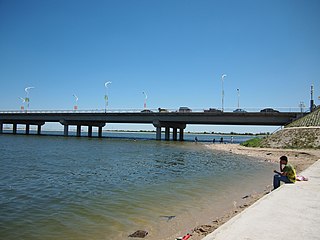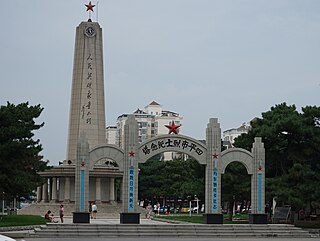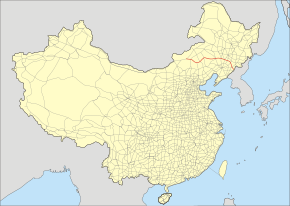
Jilin is one of the three provinces of Northeast China. Its capital and largest city is Changchun. Jilin borders North Korea and Russia to the east, Heilongjiang to the north, Liaoning to the south, and Inner Mongolia to the west. Along with the rest of Northeast China, Jilin underwent an early period of industrialization. However, Jilin's economy, characterized by heavy industry, has been facing economic difficulties with privatization. This prompted the central government to undertake a campaign called "Revitalize the Northeast". The region contains large deposits of oil shale.

China National Highway 110 (G110) runs from Beijing to Qingtongxia, via Hohhot, Baotou in Inner Mongolia, and Yinchuan. It heads northwest from Beijing to Zhangjiakou then heads straight west, and runs to approximately 1,100 kilometers (680 mi).

China National Highway 302 (G302) runs from Hunchun in Jilin to Ulanhot in Inner Mongolia. It is 1028 kilometres in length.
Villages, formally village-level divisions in China, serve as a fundamental organizational unit for its rural population. Basic local divisions like neighborhoods and communities are not informal, but have defined boundaries and designated heads. In 2000, China's densely populated villages had a population greater than 500 million and covered more than 2 million square kilometers, or more than 20% of China's total area. By 2020, all incorporated villages had road access, the last village to be connected being a remote village in Sichuan province's Butuo County.

Tongliao is a prefecture-level city in eastern Inner Mongolia, People's Republic of China. The area is 59,535 square kilometres (22,987 sq mi) and population is 3,139,153 ; the city proper has 898,895 inhabitants (2010). The city was the administrative centre of the defunct Jirem League.

Siping, formerly Ssupingkai, is a prefecture-level city in the west of Jilin province, People's Republic of China. Located in the middle of the Songliao Plain and at the intersection of Jilin, Liaoning and Inner Mongolia, Siping covers an area of 14,323 km2 (5,530 sq mi). At the 2015 census, Siping has a total population of 3.36 million while the urban population is 625,000.

Sino-Mongols, are citizens of the People's Republic of China who are ethnic Mongols. They form one of the 55 ethnic minorities officially recognized by the People's Republic of China. There are approximately 5.8 million people classified as ethnic Mongols living in China. Most of them live in Inner Mongolia, Northeast China, Xinjiang, etc. The Mongol population in China is nearly twice as much as that of the sovereign state of Mongolia.

Ulanhot, formerly known as Wangin Süm, alternatively Wang-un Süme, Ulaγanqota in Classical Mongolian, is a county-level city and the administrative center of Hinggan League in the east of the Inner Mongolia autonomous region. Formerly known as Wangyehmiao or Wangyemiao (王爺廟), the city became the first capital of Inner Mongolia, the first autonomous region in China, on 1 May 1947, until the regional capital moved to Zhangjiakou in late December 1949; the regional capital moved again in June 1952 to Hohhot, which remains the capital to this day.

The Xiliao or West Liao River is a river in Inner Mongolia and Liaoning province, in northeast China. Its source is the Xilamulun River in Inner Mongolia. It is one of the headwaters of the Liao River.

China National Highway 210 (G210) runs from Baotou, Inner Mongolia to Nanning, Guangxi. It is 3,097 kilometres in length and runs south from Baotou and passes through the province-level divisions of Shaanxi, Sichuan, Chongqing, Guizhou, and ends in Guangxi.

China National Highway 207 (G207) runs from Xilinhot, Inner Mongolia to Hai'an, Guangdong. It is 3,738 km (2,323 mi) in length and runs south from Xilinhot through Inner Mongolia, Hebei, Shanxi, Henan, Hubei, Guangxi, and ends in Guangdong.

Hexigten Banner is a banner of Inner Mongolia, China under the jurisdiction of Chifeng, bordering Hebei province to the south. In 1690 the Battle of Ulan Butung between Qing and Dzungar forces took place here.

Ar Horqin Banner is a banner of eastern Inner Mongolia, People's Republic of China. It is under the administration of Chifeng City, about 200 kilometres (120 mi) to the south-southwest. The banner lies on China National Highway 303, running from Ji'an, Jilin to Xilinhot, Inner Mongolia. The Mongolian dialect spoken in Ar Khorchin is not Khorchin, as the name suggests, but Baarin.

Horqin Right Middle Banner is a banner in the east of Inner Mongolia, China, bordering Jilin province to the east. It is under the administration of Hinggan League. The local Mongolian dialect is Khorchin Mongolian. The banner spans an area of 15,613 square kilometers in area, and has a population of 255,494 as of 2010.
The Hunchun–Ulanhot Expressway, commonly referred to as the Hunwu Expressway is a 926.22-kilometre-long expressway (575.53 mi) in the People's Republic of China that connects the cities of Hunchun, Jilin and Ulanhot, Inner Mongolia. The route parallels much of China National Highway 302.

The Daqing–Guangzhou Expressway, commonly referred to as the Daguang Expressway is an expressway that connects the cities of Daqing, Heilongjiang, and Guangzhou, Guangdong. When fully complete, it will be 3,550 km (2,210 mi) in length.
The National Winter Games of China are a nationwide Chinese winter sports competition typically held every 4 to 5 years in conjunction with the National Games of China. The 2020 winter games, which were to take place in February in Inner Mongolia, have been postponed due to the global COVID-19 pandemic. No make-up date has been announced.

Lingxia is a township of Taobei District, Baicheng, in northwestern Jilin province, People's Republic of China, located less than 5 kilometres (3.1 mi) southeast of the border with Inner Mongolia. It is served by China National Highway 302 and G12 Hunchun–Ulanhot Expressway, and as the crow flies, is more than 40 km (25 mi) northwest of downtown Baicheng and 37 km (23 mi) southeast of Ulan Hot, Inner Mongolia. As of 2011, it has 5 residential communities (社区) and 11 villages under its administration.
Bayanqolu is a Chinese politician. He is the Communist Party Secretary and former Governor of Jilin Province in Northeastern China; Bayanqolu was, at the time of his appointment, the only ethnic-minority official serving as a provincial-level Party Secretary.
Ma Ming is a former Chinese politician who spent his career in northeast China's Jilin province and the nearby Inner Mongolia Autonomous Region. He was investigated by the Communist Party of China's anti-graft agency in December 2019. Previously he served as vice chairman of the Inner Mongolia Autonomous Region Committee of the Chinese People's Political Consultative Conference.
















